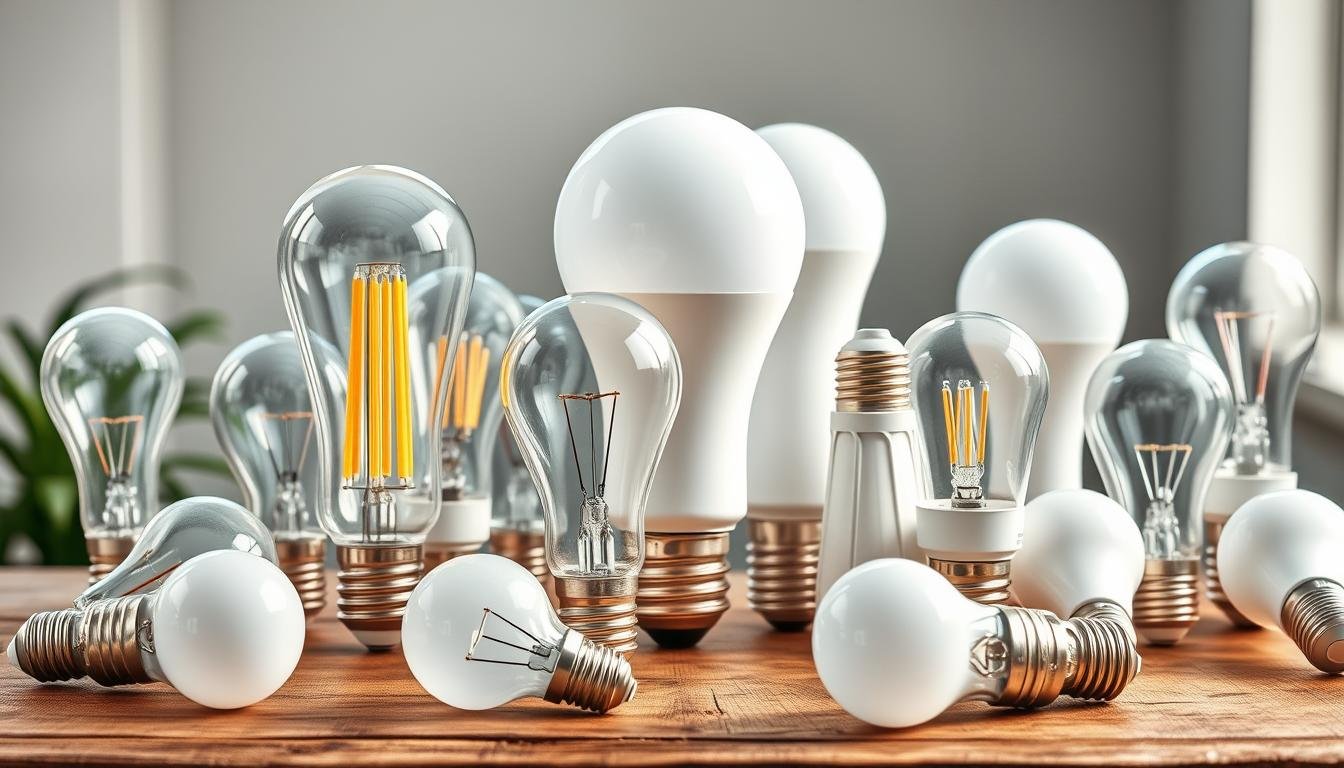Some links on this page are affiliate links. This means we may earn a commission at no additional cost to you if you click through and make a purchase. Thank you for your support!
I’m excited to share tips on energy-saving lighting. Lighting uses 15% of a home’s electricity, which is a lot. But, by using energy-efficient lights, you can save $225 a year. That’s a big cut in your energy bills.
LED technology is a game-changer. LEDs use 90% less energy than old bulbs and last 25 times longer. This means less waste and lower bills. Plus, there are many styles of LED bulbs available, from simple to outdoor lights.
Energy-saving lighting is more than just new bulbs. It’s about making your home brighter and more efficient. We’ll look at smart controls, using natural light, and zone lighting. Let’s work together to make your home brighter and greener, one light at a time.
Understanding the Impact of Lighting on Energy Consumption
Lighting is a big part of our homes and a big user of energy. The average U.S. home has about 50 light bulbs, but sadly, 60% of them are old and use too much energy. Knowing how lighting affects energy use helps us make better choices. These choices can save us money and help the environment.
Average Household Energy Usage for Lighting
Lighting makes up about 9% of our electricity bills. Most homes have around 67 light bulbs. Old bulbs use 25-80% more energy than newer, better options like LEDs or CFLs.
Potential Cost Savings with Efficient Lighting
Switching to eco-friendly lighting and smart lighting solutions can save a lot of money. LEDs use 90% less energy and last up to 15 times longer than old bulbs. By 2027, using LEDs could save the U.S. over $30 billion in energy costs.
Environmental Benefits of Energy-Efficient Lighting
Our choice of lighting affects the planet a lot. Low-wattage lamps and green lighting technology help reduce our carbon footprint. Switching to energy-efficient bulbs can save a family up to $75 a year on bills and help the planet.
| Lighting Type | Energy Usage | Lifespan | Cost Savings |
|---|---|---|---|
| Incandescent | 25-80% more energy | 1,000 hours | – |
| LED | 90% less energy | 15,000 hours | Up to $30 billion in national savings by 2027 |
| CFL | 25-35% less energy | 8,000 hours | Up to $75 per year in household savings |
“By 2027, the widespread use of LEDs could reduce the nation’s electricity use equal to the annual output of 44 large electric power plants and lead to savings of over $30 billion.”
LED Technology: The Future of Efficient Illumination
The future of lighting is here, and it’s bright with LED technology. These small, energy-saving lights are changing how we light our spaces.
LEDs save 75% or more energy compared to old bulbs and last up to 25 times longer. By 2035, most lights in the U.S. will be LEDs. This could save a huge 569 TWh in energy each year.
LEDs are special because they light up in one direction. This means they need less stuff to spread the light. They also don’t get hot, making them safer and more efficient.
- A top-notch LED bulb can last up to 30 times longer than old bulbs.
- LED lights can go up to 100,000 hours without needing a change.
- LEDs are really good at saving energy, with an efficiency of 80-90%. Old bulbs only use 20% of energy.
LEDs do more than just save energy. They can be dimmed to change the light’s look and feel. They work well in cold places and turn on fast, making them great for any spot.
LEDs are leading the way in sustainable illumination. They’re changing how we light our homes and businesses. They’re also helping make our future greener and more energy-efficient.
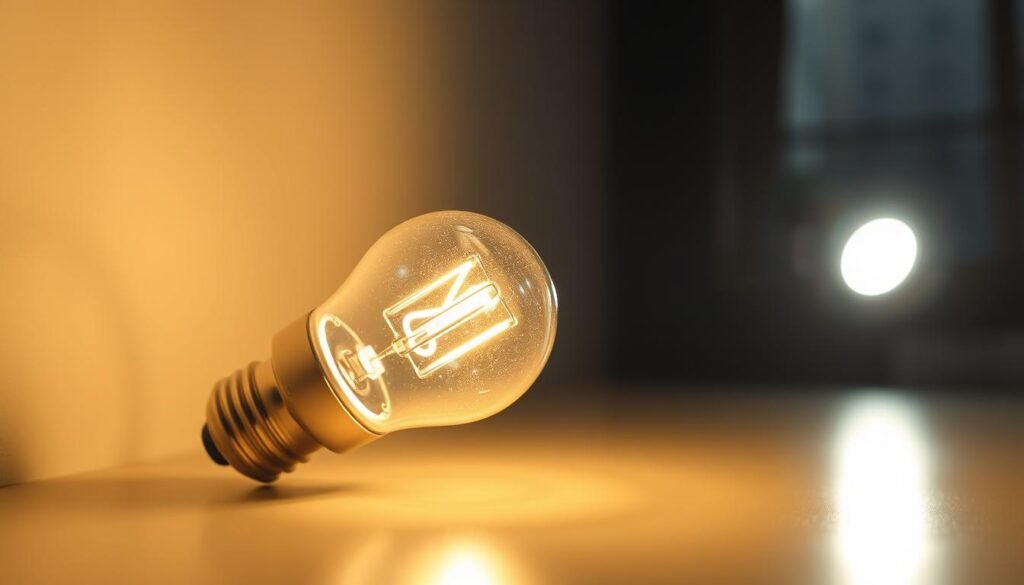
“By 2035, the majority of lighting installations in the United States are expected to be LED-based, potentially resulting in energy savings of over 569 TWh annually.”
Energy-Saving Lighting Solutions for Modern Homes
Lighting is key to an energy-efficient home. Today, we have many innovative and green lighting options. These not only save energy but also make our homes look great. You can find everything from indoor lights to outdoor ones and even smart home solutions.
Indoor Lighting Options
LED and CFL bulbs are great for replacing old incandescent bulbs. They use less energy and light up your space well. Switching to these bulbs can lower your electricity bills and help the planet.
Outdoor Lighting Solutions
Outdoor lights can also save a lot of energy. LEDs and CFLs work well for lights that are on for a long time. Look for ones with automatic shut-off and motion sensors to save even more energy and keep your home safe.
Smart Lighting Integration
Smart lighting is a big step forward for homes. It lets you control lights based on when you’re home, the time of day, or what you like. This makes your home more energy-efficient and comfortable.
Remember, natural light is also very important. Opening curtains and blinds during the day saves energy and makes you feel better. Using both energy-saving lights and natural light makes your home both green and beautiful.
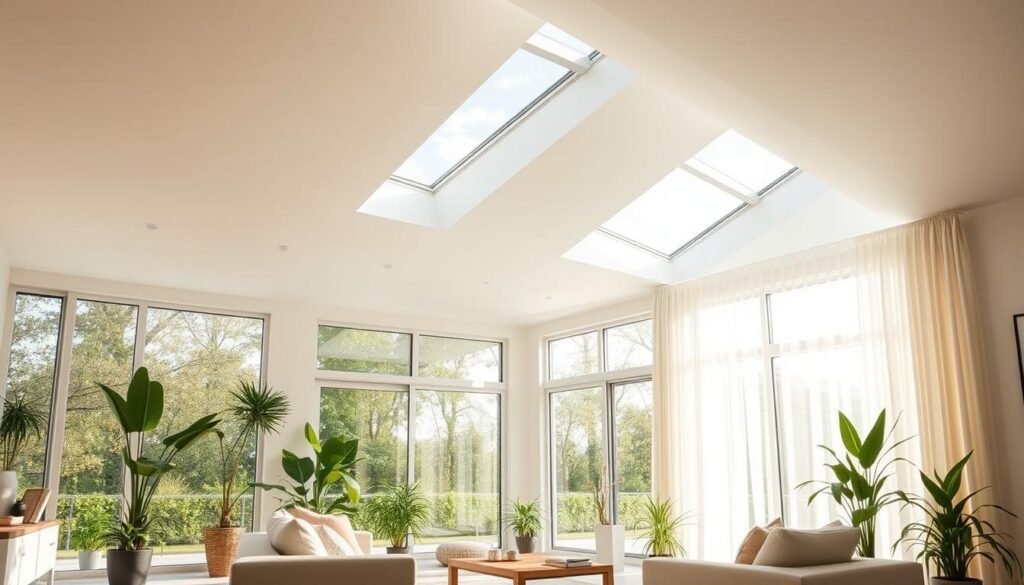
“Lighting is a crucial aspect of sustainable home design, and the options available today are truly remarkable. From energy-efficient bulbs to smart home integration, there are so many ways to create a beautiful and eco-friendly living environment.” – Allison, Sustainable Design Consultant
Cost Analysis: Traditional vs Energy-Efficient Bulbs
Lighting your home can be a big deal when you compare costs. LEDs might cost more upfront, but they save you money in the long run. They’re a wise choice for your wallet and the planet.
LEDs use 75% less energy and last 25 times longer than old bulbs. This means you’ll change bulbs less often and pay less for electricity. On average, families can save $225 per year by using LEDs.
The price of LEDs has dropped a lot since they first came out. Their long life and big energy savings make them a great deal. LEDs and compact fluorescent lights (CFLs) are good for your home and your budget.
| Lighting Type | Estimated Lifespan | Energy Usage | Estimated 20-Year Cost |
|---|---|---|---|
| Incandescent | 1,200 hours | 60 watts | $211 |
| LED | 25,000 hours | 6-28 watts | $34 |
Switching to LEDs and motion sensors saves you money and helps the environment. It’s good for your home and the planet.
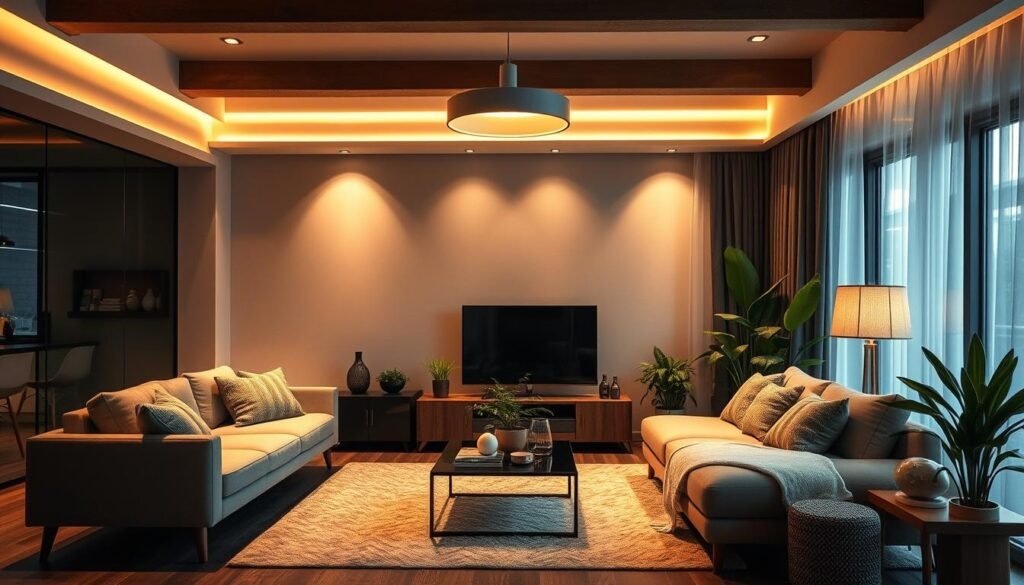
Smart Controls and Automation for Enhanced Efficiency
Discover the full potential of energy-saving lighting with smart controls and home automation. Motion sensors and timers are key to cutting down light pollution and energy waste. They make sure lights are only on when they’re needed, saving a lot of energy.
Dimmer switches offer a stylish way to control light levels. They let you adjust brightness for any situation, from a cozy evening to a bright workspace. These controls save energy and help you set the right mood at home.
Smart Home Integration Benefits
Take your energy-efficient lighting to the next level with smart home integration. By linking your lighting to a central platform, you get endless convenience and optimization. Control your lights, set schedules, and track energy use from your phone. This lets you make smart choices to lower your bills and help the planet.
The future of lighting is smart technology. Use motion sensors, timers, dimmers, and smart home integration to boost your energy-saving efforts. Your wallet and the environment will appreciate it!
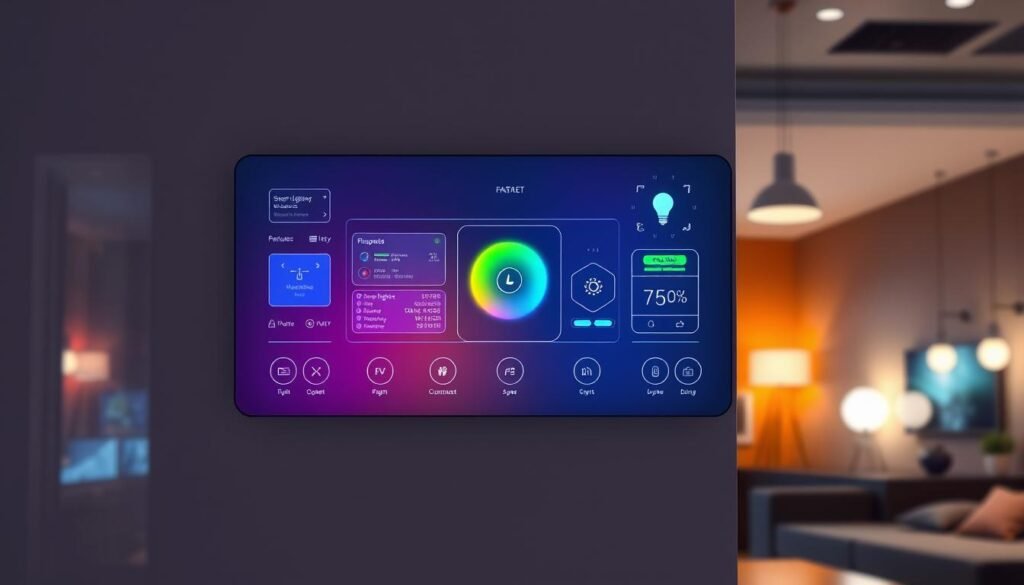
“Smart home automation can significantly reduce energy consumption, leading to an increase in energy efficiency.”
Natural Light Optimization and Daylighting Strategies
Using natural light is a great way to cut down on energy use and make your home feel cozy. Just by opening your curtains, you can use less artificial light. This can save you a lot on your electricity bills.
Studies show that buildings that use natural light well can save up to 40% on energy. This is compared to buildings that don’t use natural light as much.
One smart trick is to use mirrors to spread sunlight around your home. Mirrors can reflect light into darker areas, making you need less artificial light. Also, try using translucent lamp shades. They soften the light from your energy-saving lights, making it feel more natural.
Look into new technologies like smart glazing and dynamic daylighting systems. These can help control how much sunlight gets in while keeping your home cool. Pair these with smart lighting controls, and you’ll have a home that’s both energy-efficient and beautiful.
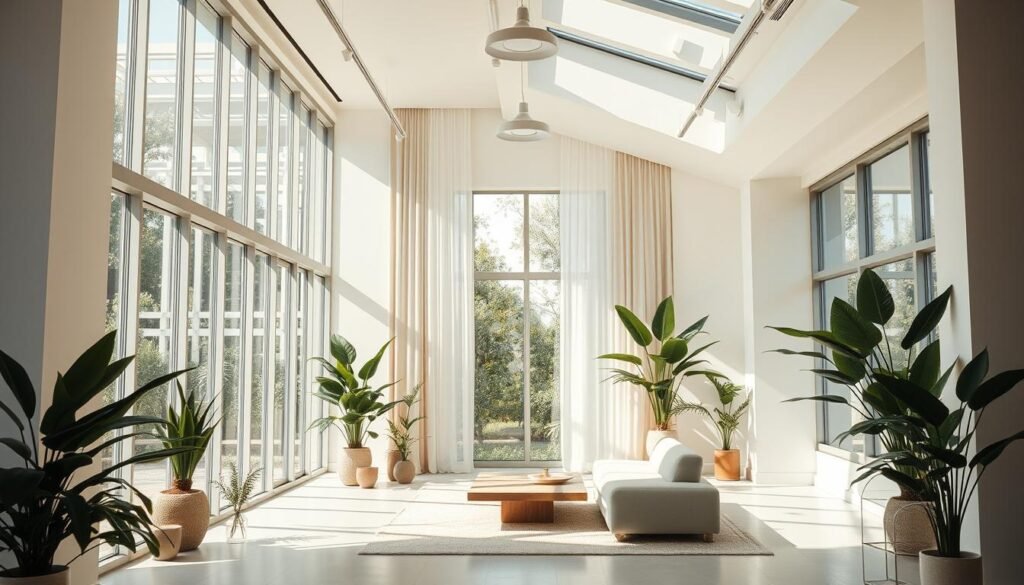
“Good daylighting design should consider both side-lighting and top-lighting characteristics, as well as the appropriate HVAC systems and lighting controls to ensure energy conservation in buildings.”
By using natural light and smart daylighting, you can make your home brighter and more comfortable. You’ll also use less energy and help the environment. So, go ahead and open those curtains. Let the sunshine in and enjoy the benefits of natural light.
Maintenance Tips for Energy-Efficient Lighting Systems
Keeping your energy-efficient lighting systems in top shape is key. It helps them work their best and save energy. Regular cleaning, timely replacements, and checking how they perform are important. This way, your LED lights and other energy-efficient bulbs will keep giving you bright, low-wattage lighting for a long time.
Cleaning and Upkeep Guidelines
Dust and dirt on light fixtures and LED lights can cut down their brightness. This might make you think you need more lights. But, cleaning them often can keep them shining bright and efficient.
Replacement Schedules
Energy-efficient bulbs like LED lights last longer than old bulbs. But, they will need to be replaced eventually. Keep an eye on when you installed them and how long they’re supposed to last. This way, you can replace them before they fail, avoiding any sudden drops in light quality.
Performance Monitoring
Watch how your lighting systems are doing. If you see flickering, dimming, or other problems, it’s time for a new one. Checking them regularly helps you catch any issues early. This keeps your low-wattage lighting running smoothly and efficiently.
By sticking to these maintenance tips, your energy-efficient lighting will stay in great condition. This saves you money on your energy bills and helps the environment by using less energy.
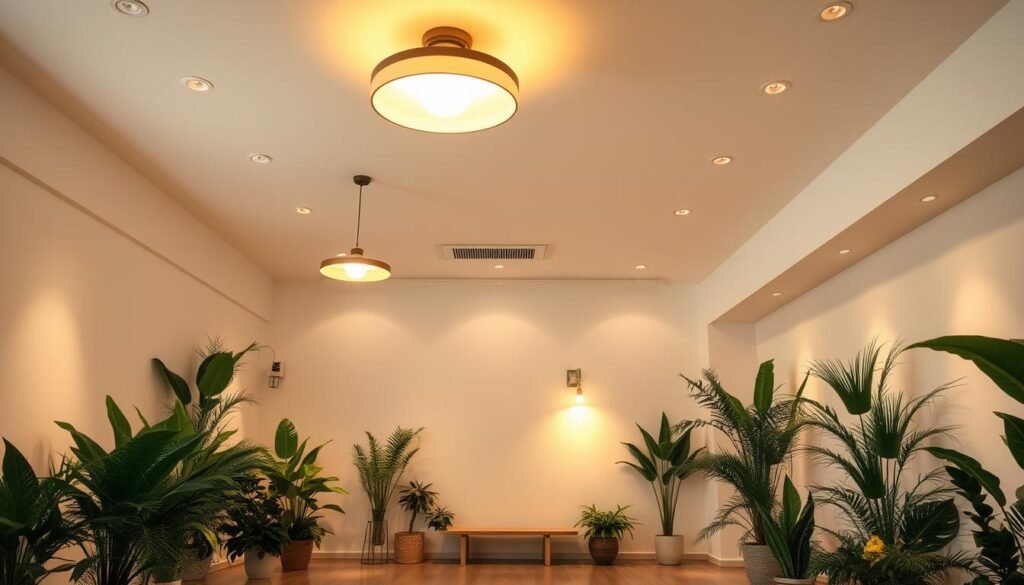
ENERGY STAR Certification and Ratings Guide
When you’re looking for eco-friendly lighting, the ENERGY STAR label is key! ENERGY STAR is a program by the U.S. Environmental Protection Agency and U.S. Department of Energy. It certifies energy-efficient products, like power-saving lamps and high-efficiency lighting.
ENERGY STAR certification means the product meets strict energy efficiency guidelines. These energy-efficient products use about 75% less energy. They also last 10 to 50 times longer than traditional incandescent lighting. Look for the ENERGY STAR label on light bulbs, fixtures, and even ceiling fans with light kits.
“Replacing one light bulb with an ENERGY STAR certified LED bulb in every American home could save about $580 million in energy costs and prevent 7 billion pounds of greenhouse gas emissions annually, equivalent to those from about 690,000 cars.”
By choosing ENERGY STAR certified products, you’re getting high-quality, eco-friendly lighting. This lighting will help reduce your energy bills and environmental impact. ENERGY STAR certified light bulbs use up to 90% less energy than standard bulbs.
They last at least 15 times longer and can save about $55 in electricity costs over their lifetime. These power-saving bulbs also produce about 70-90% less heat. This makes them safer to operate and helps cut energy costs associated with home cooling. With the ENERGY STAR label, you can trust you’re investing in sustainable lighting technologies that will benefit your wallet and the planet.
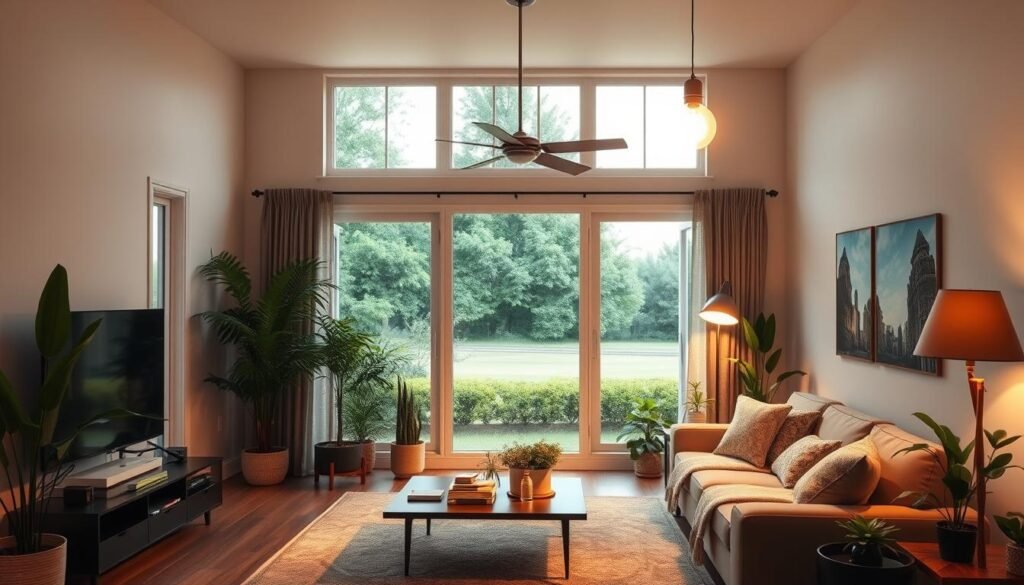
Task Lighting and Zone-Based Illumination
Task lighting and zone-based illumination are smart ways to cut down on energy use. They make sure you have the right light for each task. Instead of using old overhead lights, try energy-conserving luminaires like desk lamps or under-cabinet lights. They focus light exactly where you need it.
Workspace Lighting Solutions
For your workspace, use low-wattage bulbs or light emitting diodes (LEDs). They light up your work area without lighting up the whole room. This saves energy and makes your space more comfortable and productive.
Activity-Specific Lighting Design
Green lighting technologies let you adjust light for different activities. Bright light is great for reading or working. Soft, ambient light is better for relaxing. This design saves energy and makes your space more functional and cozy.
| Lighting Solution | Energy Efficiency | Ideal Application |
|---|---|---|
| Desk Lamps | High | Workspace Lighting |
| Under-Cabinet Lights | High | Task Lighting in Kitchens |
| Recessed Lighting | Moderate | General Lighting |
| Track Lighting | Moderate | Accent Lighting for Artwork |
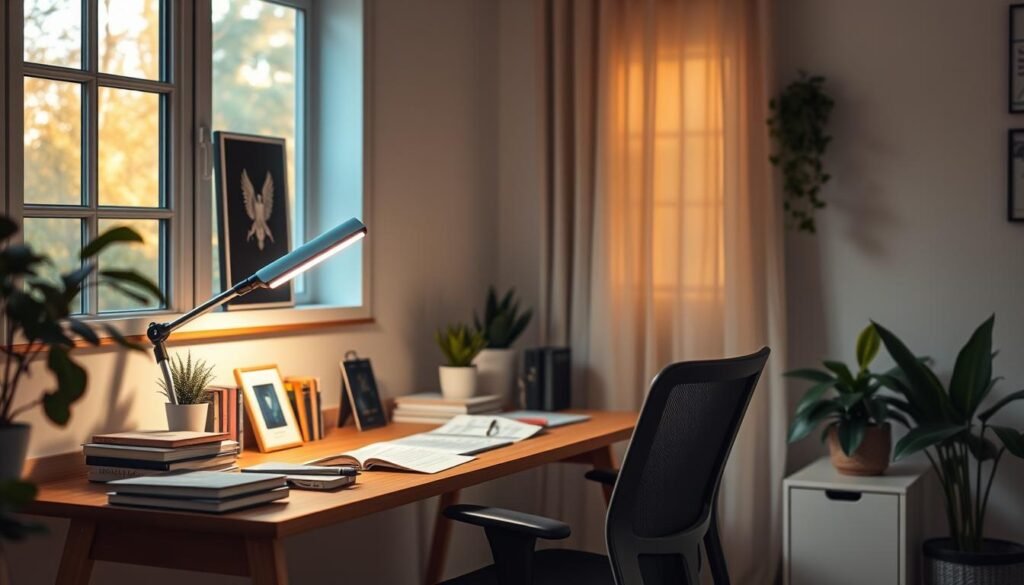
“By focusing light where it’s needed most, task lighting and zone-based illumination can help reduce energy consumption and create a more comfortable, functional living space.”
ALSO Read: How to Use Open Shelving in Industrial Interiors
Sustainable Design Principles for Lighting
Adding sustainable design to your lighting can save a lot of energy and make your home greener. Use natural light by placing windows right and adding light-reflecting surfaces. For artificial light, choose ENERGY STAR LED or CFL bulbs.
Think about the color of your lights. Cool tones are good for work areas, and warm tones for living spaces. Use a mix of ambient, task, and accent lighting for a smart setup. Controls like dimmers and smart lighting systems also help save energy and money.
By following these tips, you’ll get a lighting design that’s both green and lovely. Sustainable lighting picks materials that are good for the planet, like recycled or renewable ones. It also looks at the whole life of lighting, from making to throwing away.
ALSO READ: Spring Outdoor Decor Ideas to Refresh Your Space
Frequently Asked Questions
What are the benefits of switching to energy-efficient lighting?
Switching to energy-efficient lighting, like LEDs, can save you about 5 a year. LEDs use 90% less energy and last 25 times longer than old bulbs. They’re a smart and green choice.
How much of a home’s electricity use is typically attributed to lighting?
Lighting uses about 15% of a home’s electricity. This is a big part of your energy bill.
What are the key features that make LEDs an energy-efficient lighting solution?
LEDs are semiconductors that turn electricity into light very efficiently. They use 90% less energy and last 25 times longer than old bulbs. LEDs come in many colors and work well indoors and outdoors.
What are some other energy-saving lighting options for modern homes?
Other good choices include compact fluorescent lamps (CFLs) for indoor and outdoor use. Smart lighting, like motion sensors and timers, can also save energy. They make sure lights are only on when needed.
How can I maximize the energy-saving benefits of my lighting system?
To get the most from your energy-efficient lighting, keep it clean and check its performance often. Replace bulbs when they’re done and choose ENERGY STAR-certified products. This helps your lighting save energy and money.
What are the benefits of incorporating natural light and daylighting strategies?
Using natural light by placing windows right and using light-reflecting surfaces can cut down on artificial lighting. This lowers energy use and costs. Natural light also boosts productivity, mood, and well-being.
How can task lighting and zone-based illumination help save energy?
Using task lights and specific lighting for activities can be more efficient than overhead lighting. This focused lighting saves energy and makes your space more comfortable and useful.

